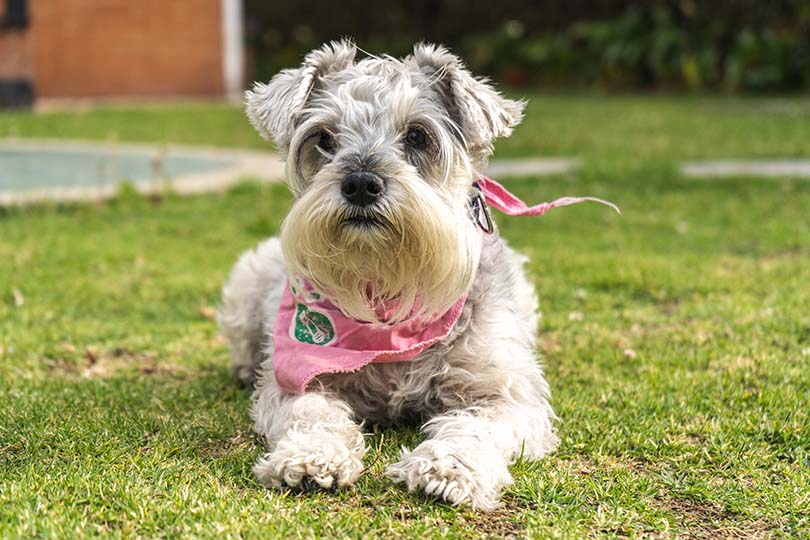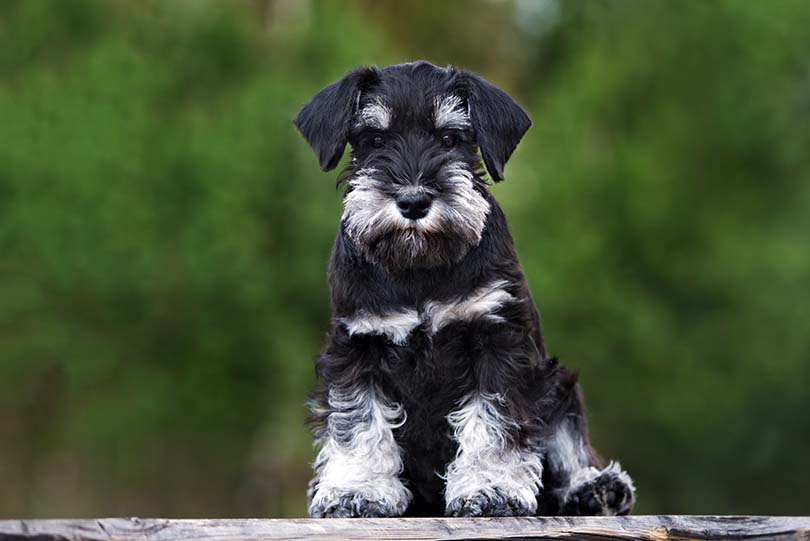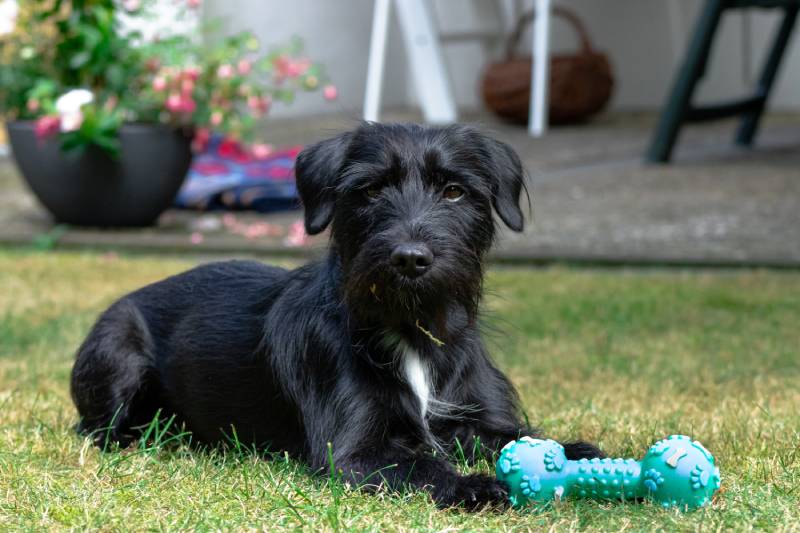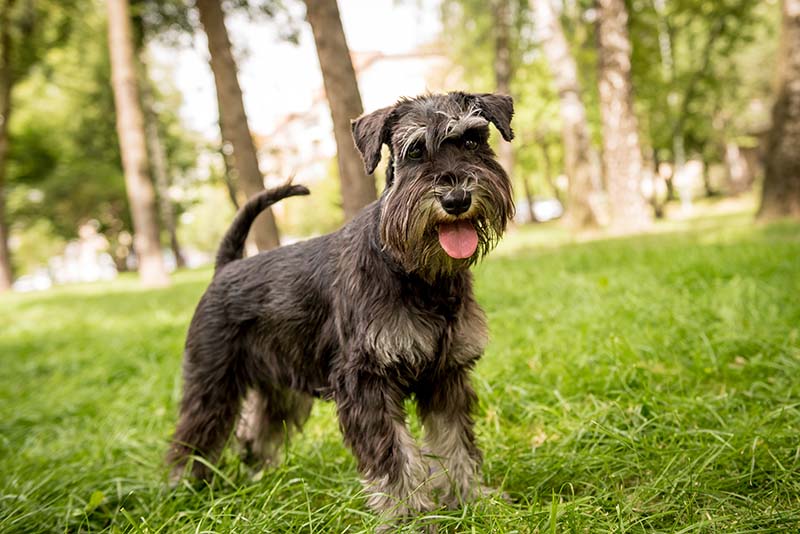Click to Skip Ahead
Miniature Schnauzers are adorably sassy dogs that make for wonderfully fun pets. Though the Miniature Schnauzer is much smaller than the Standard Schnauzer, this dog can still get larger than some expect. That’s why it’s good to understand just how big your pup will get and when you can expect it to reach full size. You also need to ensure your canine companion is growing as it should and on course to achieve growth and weight goals.
So, we’ve put together this growth and weight chart so you get an idea of where your dog needs to be and when. Keep in mind that all dogs are different, even within the same breed, but the growth and weights on this chart are what’s typical. With this chart, you’ll never have to wonder if your pup is growing as it should!

Miniature Schnauzer Overview
The Miniature Schnauzer is an incredibly popular dog in the United States (coming in at #19 on the most popular dogs list) and easily the most popular of the Schnauzers. A big part of this popularity is their large personalities that make you forget just how small they are. While Schnauzers originated in 19th century Germany and have been around for a while, Miniature Schnauzers are newer and actually came about by mixing the Poodle, the Affenpinscher, and smaller Standard Schnauzers.
Not only are these pups fun-loving and great companions, but they’re also incredibly cute with their “bearded” faces and short tails. They have lovely double coats that come in black and silver, salt and pepper, or black, too. Best of all, though, is the Miniature Schnauzer’s intelligence (the 12th most intelligent dog breed) which makes it a fairly easy breed to train.

Miniature Schnauzer Size and Growth Chart
Below, you’ll find the standard size and growth for a Miniature Schnauzer. However, several variables can affect how a puppy grows, such as sex, health, breeding, and environment. If your Miniature Schnauzer is ahead or behind this size and growth chart, you might want to talk with a veterinarian to see if there is a medical reason.
| Age | Weight Range | Length Range |
| Birth | 4–9 oz | 1–3 in |
| 1 month | 1–3 lbs | 4–6 in |
| 2 months | 2–5 lbs | 5–7 in |
| 3 months | 4–8 lbs | 6–9 in |
| 4 months | 7–11 lbs | 7–10 in |
| 6 months | 9.5–15.5 lbs | 9–11 in |
| 8 months | 11–17.5 lbs | 11–12 in |
| 10 months | 11–18 lbs | 11–13 in |
| 12 months | 11–18 lbs | 12–14 in |
| 18 months | 11–18 lbs | 12–14 in |
When Does a Miniature Schnauzer Stop Growing?
The Miniature Schnauzer should reach its adult weight and height by 12 months of age, which is typical for breeds of this size. There is a slight chance for more growth after this age, particularly when it comes to weight, though. However, after 12 months, your Miniature Schnauzer shouldn’t need to gain more weight.
This is a breed prone to obesity, so if your dog gains more weight after it reaches 12 months, check with your vet to ensure it is still at a healthy weight.

Factors Affecting the Size of Miniature Schnauzer
There are several factors that affect a Miniature Schnauzer’s height and weight. Sex, for instance, is a significant factor, as males of this breed are typically bigger than females. Even if a male and female Miniature Schnauzer are the same height, the male will most likely weigh more than the female.
Other factors play into height and weight growth, too. A proper diet and nutrition are vital to healthy growth for these pups. If a Miniature Schnauzer doesn’t receive all the nutrients it needs during its first year, it may well end up being smaller than is the norm (and potentially have issues with the musculoskeletal system).
Then there’s breeding. If your Miniature Schnauzer wasn’t bred to meet the standards for this breed, it could be smaller or larger than what is usual. And genetics plays a role in how big a Miniature Schnauzer ends up being, as well.
As you see, there are several things outside your control that could affect how your dog grows and its final size!

Ideal Diet for Maintaining a Healthy Weight
You can help your Miniature Schnauzer stay at a healthy weight by feeding it high-quality dog food rich in protein that offers all the nutrients this breed needs to maintain muscle mass and body weight. You should also speak with a vet about how much you should feed your dog; all dogs are different, even those within the same breed, and a vet will best know how much your pup should be fed to remain healthy. This will also lower the chances of you overfeeding your Miniature Schnauzer. Since these pups are prone to obesity, you want to avoid giving them too much food, keep treats to a minimum, and engage your pet in plenty of daily activity.
Feeding your Miniature Schnauzer a healthy diet also helps reduce the chances of your dog getting pancreatitis (something else this breed is prone to). This breed has a greater risk of developing bladder stones, too, so you may have to one day switch to a food that specifically reduces the risk of that. Unfortunately, foods designed to deal with bladder stones and other urinary issues can sometimes be higher in calories and fat, so watch out for that.

How to Measure Your Miniature Schnauzer
Measuring your Miniature Schnauzer is incredibly easy. The standard way to measure a dog is from the ground to its withers (aka, the highest point on the shoulder blade), so all you’ll need to do is grab a tape measure, stand your dog up, then measure from where its feet are to the withers. Standing your dog next to a wall while you do this may help, as it provides a fixed point for you during measurements. But that’s it; it’s simple!
Summary
Now you know what to expect in regard to height and weight growth for your Miniature Schnauzer, so you can help ensure your dog stays in optimal health. If you notice that your pup isn’t hitting certain growth milestones, take it to the vet to discuss whether there’s a medical reason for this. Otherwise, enjoy watching your puppy grow up!
See also:
- 7 Miniature Schnauzer Haircuts (With Pictures)
- How Much Does It Cost to Own a Miniature Schnauzer? Price Guide
Featured Image Credit By: Roman Zaiets, Shutterstock











